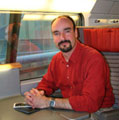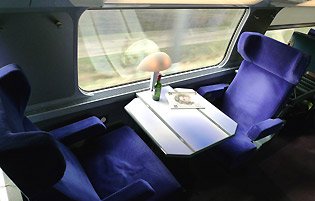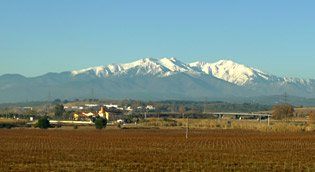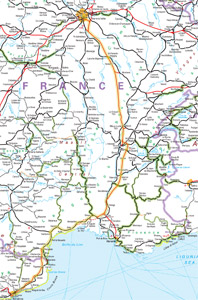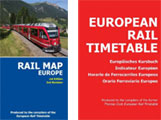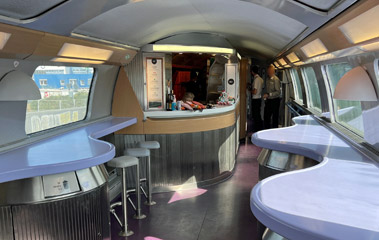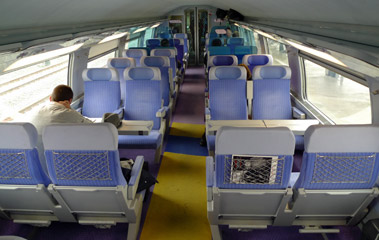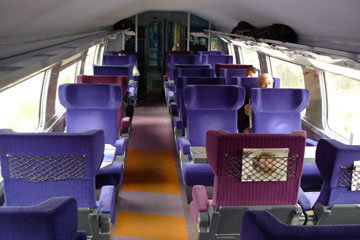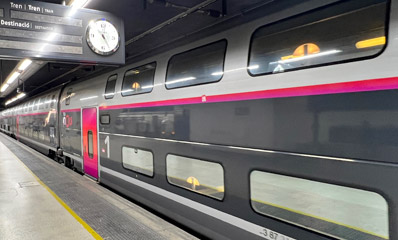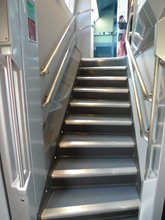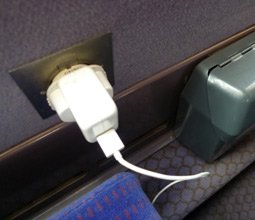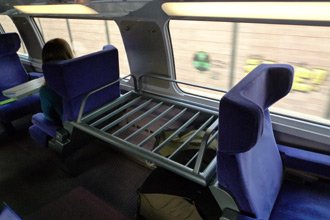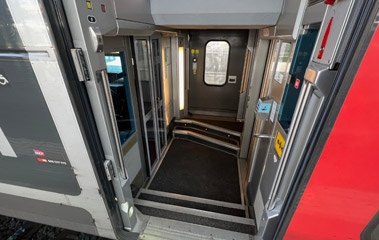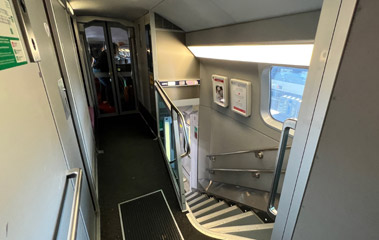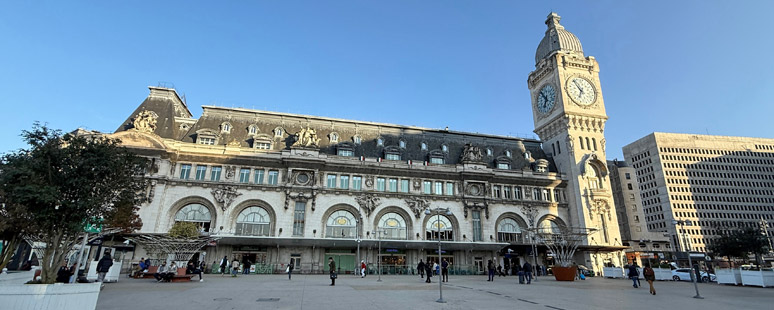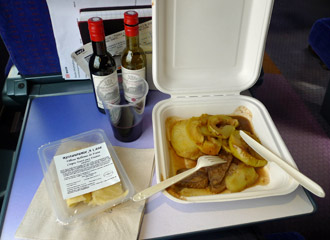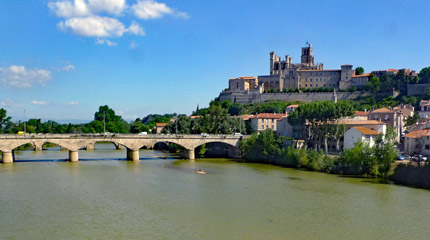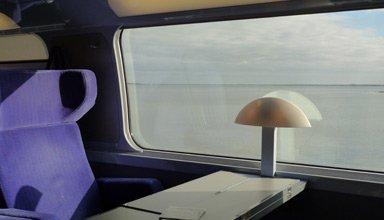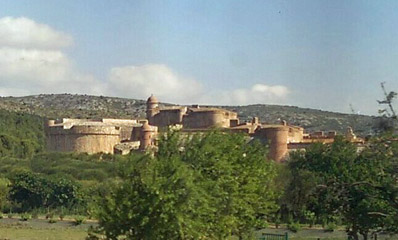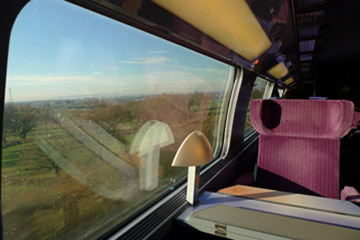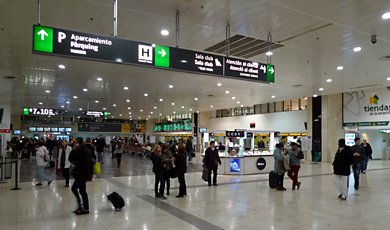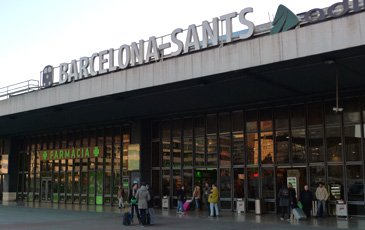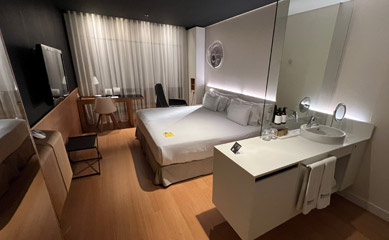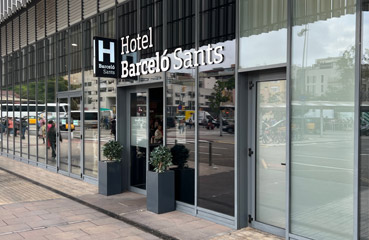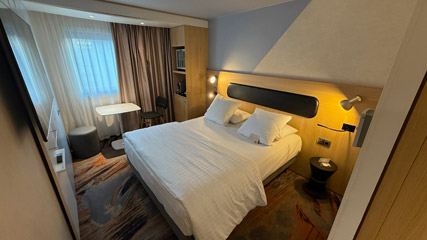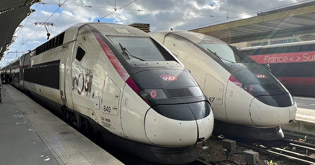 |
|
|
Relax with a glass of red at a 1st class upper deck table for 2 on a TGV Duplex from Paris to Barcelona. Speed along the Rhone Valley at 186mph past pretty French villages, watch for the flamingos on the étangs (lakes) in the South of France with glimpses of the Mediterranean. Skirt the Pyrenees to arrive in central Barcelona, 6h39 from Paris. Flying takes 4-5 disjointed hours with 10 times the CO2 emissions. See the photos Watch the video
Mt Canigou (2,784m) in the Pyrenees is clearly visible on your right as your train leaves Perpignan & heads into Spain |
Paris to Barcelona by train from €39
Double-deck TGV Duplex high-speed trains link Paris Gare de Lyon with Figueres, Girona & Barcelona at up to 320 km/h (199 mph). Paris to Barcelona takes a leisurely 6h50 city centre to city centre for the 1,073 km (667 miles), compared to a tedious 5 hours by air once ground transportation, check-in time and airport security are included. Forget flying, chill out with a glass or two of red wine and enjoy the ride along the scenic Rhone Valley, watch for the flocks of flamingos on the étangs (lakes) in the south of France, and glimpse the coast and the Pyrenees before arriving in the centre of Barcelona. Watch the video guide.
![]() Travel tips - definitely read these!
Travel tips - definitely read these!
![]() Tips for making the journey cheaper
Tips for making the journey cheaper
![]() Paris to Barcelona by
sleeper train
Paris to Barcelona by
sleeper train
![]() Train travel in Spain, a beginner's guide
Train travel in Spain, a beginner's guide
![]() General information for European train travel
General information for European train travel
Train times southbound 2026
Train times northbound 2026
Read downwards, each column is a train you can take.
* Nimes Pont du Gard & Montpelier Sud de France stations are several inconvenient kilometres out of town.
You can check train times for your date of travel at www.raileurope.com, www.thetrainline.com or www.sncf-connect.com.
Paris to Barcelona by train is 1,073 km (667 miles). These TGVs average around 105 mph including stops.
Figueres Vilafant station is 5 kilometres from Figueres city centre, taxis are available.
Paris Gare de Lyon station guide Barcelona Sants station guide
For sleeper trains between Paris & Barcelona see here.
How much does it cost?
Fares vary like air fares, they can sell every seat for €99 or more in summer and at other busy times.
Cheap fares = Prems, Mini, Essential or Leisure fares = Book in advance, price varies like air fares, limited or no refunds or changes.
Full-price = Refundable and flexible. There are no senior or youth reductions.
Child fare = Child 4-11 years, use an adult special fare if cheaper, as it often is. Children under 4 free.
How to buy tickets
Which website to use?
All these websites charge the same fares, but some add a booking fee, some don't, some offer seating options, some allocate your seat.
Option 1, www.sncf-connect.com
This is SNCF's (French Railways) own website, prices in €. There's no booking fee, you can select upper or lower deck and when you buy a 1st class ticket you can choose your seat from a seat map. However, it can't book onward trains within Spain.
Option 2, www.thetrainline.com
Easy to use, prices in €, £, $, overseas credit cards no problem, small booking fee. You can select upper or lower deck, and when you buy a 1st class ticket you can choose your seat from a seat map. It also connects to the Renfe (Spanish Railways) ticketing system so you can buy onward tickets in Spain here, too. About Thetrainline.com.
Option 3, www.raileurope.com
Easy to use, prices in €, £, $, overseas credit cards no problem, small booking fee. You can select upper or lower deck. It also connects to the Renfe (Spanish Railways) ticketing system so you can buy onward tickets in Spain here, too. About Raileurope.com.
When do bookings open?
Bookings for Paris-Barcelona trains open up to 6 months before departure, but this varies and can be less. Bookings for dates immediately after the timetable change in mid-December usually open in October.
How are tickets delivered?
In all cases, you can print out your ticket or show it on your phone.
Interrail & Eurail passes
Seat reservation is required, make reservations as shown here.
Seat maps
See TGV Duplex seat map. Car 1 (= car 11 in the second TGV unit on a 2-unit train) is usually at the Paris end of the train, but this can't be guaranteed as the unit could enter service either way round. Seat numbers will change to a new 3-digit system from mid-December 2025, see new seat map.
Will a Carte Avantage discount card save you money?
A Carte Avantage can sometimes pay for itself on just one trip, especially if you see high prices when you try to book, or if there are two of you or if you're a family.
A Carte Avantage costs €49 for 1 year and gives you and a companion 30% off normal fares on TGVs & Intercités, which includes the Paris-Barcelona TGVs, for one-way journeys at weekends, or for round trips which include a Friday, Saturday or Sunday night away, or at any time if you're accompanied by at least one child under 12, see more information here. Up to 3 accompanying children under 12 get 60% off.
Rail Europe can't sell tickets with Carte Avantage discount applied, so use www.sncf-connect.com or www.thetrainline.com. To see if the saving justifies the cost of the card, run an enquiry on www.sncf-connect.com or www.thetrainline.com without a Carte Avantage added, then run the enquiry again with a Carte Avantage Adulte added to one of the adults.
Route map
What's the train like?
The Paris to Barcelona trains are impressive TGV Duplex double-deck high-speed trains. They reach 300 km/h (186 mph) on the Sud-Est high-speed line between Paris & Nimes, and up to 320 km/h (199 mph) on the line between Perpignan & Barcelona. Watch the TGV video.
You board the train at the lower level through a wide sliding door into an entrance area at one end of the lower deck. Here, there's a toilet and door into the lower deck seating area. A short & easy flight of 9 steps leads up to the landing at one end of the upper deck, with an upstairs toilet and door to the upstairs seating. You walk along the train from car to car at the upper level. There are luggage racks upstairs and downstairs, at the coach ends and between seats. See seat map for Paris-Barcelona TGVs. See new seat map from 14 December 2025.
If you have significant problems with stairs or very heavy luggage, the lower deck might be best. But for the best views (over the top of the occasional sound barrier along the high speed lines!), definitely choose an upper deck seat, the stairs are easy and there are toilets & luggage space upstairs. For couples in first class, an upper deck club duo face-to-face table-for-two is the best option if you can get it.
There are baby-changing facilities and designated spaces for passengers in wheelchairs near an accessible toilet.
Cafe-bar: There's a cafe-bar on the upper deck in car 4 in the centre of the train between the 1st & 2nd class cars. The coffee is good, credit cards are accepted. There's an area where you can eat & drink or you can take it back to your seat. see sample TGV menu. You can skip the queue by ordering on your phone for collection at the cafe-bar counter, see the travel tips section. Or feel free to bring your own food & even beer or wine along for the journey to consume at your seat.
Power sockets: There are power sockets at every seat, standard European 230V 2-pin type.
WiFi: SNCF equipped these international TGVs with free WiFi in 2019, the network appears as Le WiFi. If you have a 3G or 4G mobile data package, that works fine along the majority of this route.
The afternoon TGV Duplex to Barcelona, about to leave Paris Gare de Lyon. Watch the video.
What's the journey like?
1. Paris Gare de Lyon. The trains to Barcelona leave from the magnificent Gare de Lyon in central Paris. See station guide.
Hall 1 at the Gare de Lyon. The TGV may leave from Hall 1 or Hall 2, see station guide.
Lunch at the famous Train Bleu restaurant at the Gare de Lyon before catching the Barcelona Express? Larger photo.
Or have a coffee or beer in the bar inside the Train Bleu, which makes an excellent VIP waiting lounge.
2. Paris to the outskirts of Lyon. The train leaves the Gare de Lyon and joins the high-speed line, accelerating smoothly to 300 km/h through the suburbs, soon reaching open country. Between Paris and the outskirts of Lyon the train runs through undulating countryside with villages and farms nestling in small valleys.
3. Rhone Valley. South of Lyon the train powers down the Rhône Valley, past pretty villages with picturesque churches and the occasional chateau.
Watch for hilltop villages.
On a clear day you can see the snow-capped French Alps in the far distance on the left, and the dark line of the Massif central in the far distance on the right.
4. The Rhone & Chateau de Montfaucon. Between Valence and Nîmes the train crosses a broad stretch of the River Rhone with a view of the wine-producing Chateau de Montfaucon on the right, www.chateaumontfaucon.com.
5. Béziers. The train calls at Nimes and Montpelier and continues west through Sète and Agde. As the train crosses the River Orb just after Béziers station, look right for views of Béziers' 13th century cathedral (yes, the photo above right was taken from the train, these all were!).
Above left, lunch from the cafe-bar, a magret de canard avec pommes de terre and some wine from the cafe-bar. By all means bring your own picnic and wine!
6. The Mediterranean coast. Between Montpellier & Perpignan the train skirts the glistening Mediterranean coastline with deserted beaches & marshland.
7. Vineyards (above right). The train passes countless vineyards. Glass o' red from the bar car, anyone?
8. Étangs & flamingos. Between Narbonne & Perpignan the train passes numerous étangs (lakes), where flamingos stand one-legged in the shallows.
9. The Fort de Salses. Just before Perpignan, the train passes by the impressive Fort de Salses on the right, a 15th-century Catalan fortress captured in 1642 and French-held ever since, see en.wikipedia.org/wiki/Fort_de_Salses.
10. Mt Canigou & the Pyrenees. One of the highest peaks in the mighty Pyrenees, the 2,784m (9,137 feet) high Mt Canigou dominates the skyline on the right all the way from Perpignan to Girona, see en.wikipedia.org/wiki/Canigou.
11. Arrival at Barcelona Sants, a modern station in central Barcelona with plenty of taxis and a metro to all parts of Barcelona, see Barcelona Sants station guide. There are left luggage lockers (consigna). Photo courtesy of Brian's Coffee Spot.
X-ray check when boarding in Barcelona: At Spanish stations including Barcelona Sants, there's a quick X-ray check of all baggage before you can go onto the high-speed platforms, which includes boarding a northbound TGV to France. There are usually no metal detectors, so you can carry what you like on your person, it's only your baggage that's checked. Make sure that any (perfectly legal) penknives, corkscrews etc are in your pockets not your baggage so don't get scanned, to avoid a jobsworth refusing to allow them on, as happened to one passenger. There is no such check at any French station, where there is free & easy access to the train. More about Barcelona Sants station.
Video guide: Barcelona to Paris
A journey from Barcelona to Paris by TGV Duplex, showing train & scenery.
Travel tips
Should you go 1st or 2nd class?
2nd class is absolutely fine, no need to pay for 1st class unless you want to. There's no food or drink included in 1st class, it's just the extra elbow and leg room you're paying for. On the other hand, first class seats are arranged 2+1 across the car width, so there are individual 'solo' seats and tables-for-two in 1st class as well as the dual-side-by-side and tables-for-four which you'll also find in 2nd class where seats are arranged 2+2 across the car width. Prices vary in both classes, sometimes 1st class is little more (or can even be less) than 2nd class, check prices before you decide.
Upper deck seats are best!
Whichever class you choose, I recommend an upper deck seat for the best views. It's only 9 wide and easy stairs up from the entrance and once upstairs you can walk along the train to the cafe-bar, there are toilets & luggage space.
Forward-facing seats
You cannot select forward-facing seats, but car 1 (or in the second TGV unit, car 11) is normally at the Paris end of the train and you can work out which way seats face from the seat map. These trains usually leave Paris as two TGV Duplex units coupled together. Cars 1-8 at the rear are uncoupled at Perpignan, cars 11-18 up front continue to Barcelona.
How to give your baby or toddler their own seat
Infants under 4 go free on both the TGV and Frecciarossa, no need to buy them a ticket, just bring them along. However, if they go free they don't qualify for their own seat, they go on your lap.
On Paris-Barcelona TGVs you can give them their own seat for a flat-fare €9 Billet Bambin. Well worth it! Simply add your infant to your booking with their correct date of birth.
The best place to wait for the train in Paris
I highly recommend using the bar or having a meal at the celebrated Train Bleu restaurant inside the Gare de Lyon (Hall 1). Opened in 1903, it's a listed national monument, and an experience in itself. You can reserve a table for lunch or dinner online at www.le-train-bleu.com.
Boarding the train in Paris
See the Paris Gare de Lyon station guide. There's easy level access from street to concourse to platform in Paris. There's no check-in, you can wander off the street onto the station concourse, see which platform your train will go from on the various departure screens, then go to that platform.
At Paris Gare de Lyon there are automatic ticket gates at the entrance to each platform, place the QR code on your ticket or phone in front of the ticket gate scanner any time up to 2 minutes before the train goes and the gate will open.
The platform number may not be posted until 20 minutes before departure, but the departure boards at the Gare de Lyon will tell you whether it will leave from Hall 1 (blue, platforms A to N) or Hall 2 (yellow, platforms 5-23) so you can wait on the right concourse close to where the train will leave. The original historic concourse with the Train Bleu Restaurant and platforms A to N is Hall 1, the newer concourse with platforms 5-23 is Hall 2, accessed through the ticket hall.
Boarding the train in Barcelona & other Spanish stations
In Spanish stations there's a brief X-ray baggage scan when entering the departures area, that's what the Spanish do for all their high-speed trains. So don't cut it too fine when starting your journey in Spain. See Barcelona Sants station guide.
Order food & drink on your phone to skip the line at the cafe-bar!
The queue to be served at the cafe-bar counter can often be long, but you can skip the line by ordering on your phone.
When you're on board the train, log on to the train's WiFi and open the SNCF intranet, you'll find a page for ordering food & drink. They'll give you a 15-minute time slot for picking it up from the cafe-bar counter, when the time comes you can go straight to the front of the queue to collect your food & drink, saving a lot of time waiting to be served!
Or you can order online in advance, either on the day of travel or a day or two beforehand, at lebar.sncf-connect.com (please let me know if that link stops working).
You enter the train number and date and it'll tell you whether this service is available on that train and open for booking. If it is, you can order any food & drink you like, and choose a time slot for collecting it from the cafe-bar counter on board. When the time comes, just walk straight to the front of the queue!
Luggage & luggage limits
Luggage works just as it does on any other European train. You take your bags onto the train with you and put them on the racks above your seat or between the seats or at the car ends. There are racks both upstairs & downstairs, and the stairs to the upper deck are shallow and wide enough to make taking bags upper deck pretty easy. I always find a rack right near my seat, so I can easily see my bags from my seat and access them when needed. It's as simple as that.
From 2024 there's a more formal luggage limit for Paris-Barcelona TGVs: You may bring up to 3 pieces of luggage no larger than 85 x 55 x 35 cm weighing a total of 25 Kg. You can also bring one piece of hand luggage no larger than 46 x 70 cm weighing less than 30 Kg. Luggage can include skis, baby seats, golf bags, surfboards stored in a bag no larger than 120 x 90 cm, wheelchairs, bicycles that have been disassembled and stored in a bag no larger than 120 x 90 cm. Luggage must have a visible label with the traveller’s first and last name.
Taking bikes
Bikes are carried free of charge on these Paris-Barcelona TGV trains. They go as ordinary luggage, and must be semi-dismantled and placed in a zip-up bike bag not exceeding 120cm x 90cm. See the Taking bikes on trains page.
Dogs & pets
See the Taking dogs by train page.
Do these trains run on time?
You can see for yourself how punctual these TGVs are using Zugfinder, although data only covers the French part of the journey. Click these links to see punctuality over the last 30 days: Morning southbound TGV. Afternoon southbound TGV. Morning northbound TGV. Afternoon northbound TGV.
Figueres is worth a stop
It's home to the amazing Salvador Dali museum, and Dali's home at Port Lligat is just a bus or taxi ride away on the coast, also well worth visiting.
Paris-Barcelona by sleeper train
The direct Paris-Barcelona trainhotel was sadly discontinued in 2013, but you can still travel between Paris & Barcelona using a French sleeper train between Paris & the Spanish border and connecting local train to Barcelona. See the Paris to Barcelona by sleeper train page.
Tips for making the journey cheaper
If the TGV is expensive
SNCF seem to be under-providing and over-pricing the Paris-Barcelona route these days. Here are two tips which might make your TGV journey cheaper:
Split the booking at Perpignan
If you only see expensive €120+ fares from Paris to Barcelona, try splitting the booking at Perpignan.
On one date I picked, Paris-Barcelona by TGV cost €170, but Paris-Perpignan on the same train cost €60 then Perpignan-Barcelona (also on the same train) cost €29, a total cost of €89, a 47% saving. Splitting the journey won't always save money, but it's worth checking.
Set up an enquiry from Paris to Barcelona, click More options and enter Perpignan, leaving stopover time as zero. Then run the enquiry. Raileurope.com will automatically split the ticket at Perpignan. Compare the prices you see with the prices you get without the Perpignan split.
You'll need to switch seats at Perpignan as you are unlikely to be given the same seat for both parts of the trip. The train often consists of two 8-car TGV units coupled together between Paris & Perpignan, each with a different train number, only one 8-car unit runs beyond Perpignan to Barcelona, usually with car numbers 11-18. The other unit (usually car numbers 1-8) only operates between Paris & Perpignan. If you're lucky your Paris-Perpignan seats will be in the Paris-Barcelona unit, and you can simply walk down the train any time to your new seats, but if you get Paris-Perpignan seats with a different train number you'll need to nip out onto the platform when the train arrives at Perpignan, walk forward to the front TGV unit and re-board, you won't be able to walk through the train. The trains stops at Perpignan for several minutes while the two units are coupled/uncoupled, it only takes a minute to nip out and walk forward.
See if a Carte Avantage saves money
French Railways have a discount card called Carte Avantage. The saving can sometimes justify the cost of the card for just one Paris-Barcelona round trip, especially if there are two of you or you're a family, or when fares are high.
A Carte Avantage Adulte costs €49 for 1 year and gives you and a companion 30% off normal fares on TGVs & Intercités (including Paris-Barcelona) for one-way journeys at weekends, or for round trips which include a Friday, Saturday or Sunday night away, or at any time if accompanied by a child under 12, see more about Carte Avantage. Up to 3 accompanying children under 12 get 60% off. You also get discounts on many TER regional trains. There are also youth & senior versions, without the weekday restrictions.
Rail Europe can't sell tickets with Carte Avantage discount, so book with www.thetrainline.com or www.sncf-connect.com instead. There's no discount on Eurostar, but you'll get any applicable discount on Paris-Barcelona.
To see what the saving is and to check if that justifies the cost of a card, go to www.thetrainline.com or www.sncf-connect.com and run a Paris-Barcelona enquiry without a Carte Avantage added, then run again with a Carte Avantage Adulte added to one of the adults.
Hotels in Barcelona
Hotels close to Barcelona Sants station, for an overnight stop: If you're only stopping in Barcelona briefly between trains, a hotel close to Barcelona Sants station might be best. Here are some near the station with good or great reviews: Hotel Barcelo Sants (4-star, great reviews, directly above Barcelona Sants station itself, recommended), AC Hotel Sants by Marriott (4-star, just 50m from the station), Hotel Catalonia Roma (3-star), Hostal Baler (2-star), Hotel Transit (1-star), Meeting Point Hostel (inexpensive private rooms & dorm beds).
Hotels in the old city, for a longer stay: For a longer stay, get a hotel in the old quarter, perhaps on or near La Rambla itself, such as the following hotels with good or great reviews: Hotel DO Plaça Reial (5-star, fabulous, around £200+), Hotel Espana (4-star, around £190, one of Barcelona's most historic & well-known hotels in a quiet location just off La Rambla), Hotel MonteCarlo (4-star), Hotel Jazz (3-star with roof-top pool, from around £160 per night), Hotel Catalonia Portal de l'Angel (3-star with outdoor swimming pool, Gothic quarter, around £130 for a double), Hotel Curious (2-star, 50m from Las Ramblas, from around £90 for a double).
Hotels in Paris
Hotels near the Gare de Lyon with good reviews: Hotel Terminus Lyon (right in front of the station, 3-star, doubles €139); Mercure Paris Gare de Lyon (on the station itself, 4-star, doubles €120); Novotel Paris Gare de Lyon (opposite the station, 4-star, doubles €139); Mistral Hotel (800m from Gare de Lyon, 1-star, doubles €68); Hotel 26 Faubourg (5 min walk from Gare de Lyon, 2-star, doubles €86);
The Mercure Hotel entrance, next to the Gare de Lyon's famous clock tower.
For something special. There's the famous & flashy Paris Ritz in the Place Vendôme of course (over €500 a night) or the similarly-priced Le Meurice, but if you want a really special hotel for a luxury break or romantic weekend and can afford to splurge around €290 a night, I'd recommend the small, sumptuous and intimate L'Hotel. It's on the bohemian left bank, walking distance from the Seine, the Ile de la Cité & Notre Dame. Oscar Wilde spent the last days of his life here in room 16, and the hotel has been used by many famous people from Sinatra to Mick Jagger. Rooms are on the cosy side, but they are beautifully decorated and have character that other hotels lack.
